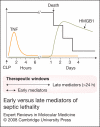Therapeutic potential of HMGB1-targeting agents in sepsis
- PMID: 18980707
- PMCID: PMC2586610
- DOI: 10.1017/S1462399408000884
Therapeutic potential of HMGB1-targeting agents in sepsis
Abstract
Sepsis refers to a systemic inflammatory response syndrome resulting from a microbial infection. The inflammatory response is partly mediated by innate immune cells (such as macrophages, monocytes and neutrophils), which not only ingest and eliminate invading pathogens but also initiate an inflammatory response upon recognition of pathogen-associated molecular patterns (PAMPs). The prevailing theories of sepsis as a dysregulated inflammatory response, as manifested by excessive release of inflammatory mediators such as tumour necrosis factor and high-mobility group box 1 protein (HMGB1), are supported by extensive studies employing animal models of sepsis. Here we review emerging evidence that support extracellular HMGB1 as a late mediator of experimental sepsis, and discuss the therapeutic potential of several HMGB1-targeting agents (including neutralising antibodies and steroid-like tanshinones) in experimental sepsis.
Figures




References
-
- Serhan C.N.. Savill J.. Resolution of inflammation: the beginning programs the end. Nat Immunol. 2005;6:1191–1197. and . - PubMed
-
- Dellinger R.P.. et al.Surviving Sepsis Campaign: international guidelines for management of severe sepsis and septic shock: 2008. Crit Care Med. 2008;36:296–327. - PubMed
-
- Luster A.D., Alon R.. von Andrian U.H.. Immune cell migration in inflammation: present and future therapeutic targets. Nat Immunol. 2005;6:1182–1190. , and . - PubMed
-
- Scapini P.. et al.The neutrophil as a cellular source of chemokines. Immunol Rev. 2000;177:195–203. - PubMed
-
- Liles W.C.. Immunomodulatory approaches to augment phagocyte-mediated host defense for treatment of infectious diseases. Semin Respir Infect. 2001;16:11–17. - PubMed
Further reading, resources and contacts
-
- Chadwick D.J. Goode J. New Therapies. John Wiley & Sons; New York, USA: 2007. Novartis Foundation Symposium 280: Sepsis – New Insights. and . , eds (
-
Sepsis.com provides more information about the signs, diagnosis and potential treatment for severe sepsis:
-
- http://www.sepsis.com http://www.sepsis.com
-
Surviving sepsis.org promotes the Surviving Sepsis Campaign (SSC), an initiative to improve the management, diagnosis and treatment of sepsis:
-
- http://www.survivingsepsis.org http://www.survivingsepsis.org
-
MDidea.com provides a detailed description about potential use of Danshen and components (Tanshinone IIA) in the treatment of various inflammatory ailments:
Publication types
MeSH terms
Substances
Grants and funding
LinkOut - more resources
Full Text Sources
Other Literature Sources
Medical

